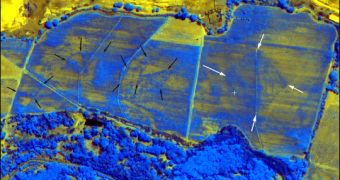The latest advances in technology have allowed Italian researchers to see beneath the soil of the Cahuachi Peruvian desert from satellite heights. Lying deep under the mud, there is a large, ancient adobe pyramid.
Scientists Nicola Masini and Rosa Lasaponara from Italy's National Research Council (CNR) have thoroughly analyzed a large number of images captured by the Quickbird satellite using a recently developed remote sensing technology. This technique allowed to bypass thick layers of rocks and mud near the Nazca river, about a mile (1.6 km) away from the Cahuachi archaeological remains of the largest mud city in the world.
By improving the high-resolution multispectral and infrared images via complex algorithms, the researchers discovered that a great ancient adobe pyramid was buried in the soil. The 9,000 square mile (23.310 square kilometer)-wide structure finding didn't surprise them, since the 40 Cahuachi mounds were previously known to house the ruins of some important structures.
“We know that many buildings are still buried under Cahuachi's sands, but until now, it was almost impossible to exactly locate them and detect their shape from an aerial view,” Masini told Discovery News. “The biggest problem was the very low contrast between adobe, which is sun-dried earth, and the background subsoil.”
The Cahuachi site is one of the best known to have housed the Nazca civilization (1st century BC to 5th century AD), responsible for the famous drawings in the desert. The location at Cahuachi seems to have served as a ceremonial center, adorned with temples, pyramids and plazas. The natural catastrophes that hit the region (a massive flood and a powerful earthquake) caused the Nazca people to seal their monuments, bury them under the sand, and leave.
Giuseppe Orefici, an archaeologist who excavated in the Cahuachi for decades, having also worked with the CNR scientists, notes, “Up to now, we have completely unearthed and restored a huge asymmetrical pyramid, known as the Grand Pyramid. A terraced temple and a smaller pyramid are in an advanced state of excavation.” The 300-by-328-foot (91.5 by 100 meter) base, 7-leveled, newly discovered pyramid has at least “four degrading terraces which suggest a truncated pyramid similar to the Grand Pyramid.”
Researchers estimate to find remains of human sacrifices inside the monument, following the previous discovery of 20 severed “offering heads” in the Grand Pyramid. “They have circular holes cut into the forehead and were perfectly prepared from an anatomical point of view,” states Andrea Drusini, an anthropologist from the Padova University in Italy.
The experts are also focusing their attention on other buried structures in the area. “This innovative technology opens up new perspectives for the detection of buried adobe monuments in Cahuachi and elsewhere,” explains Masini. “Once we have more information about the size and shape of the structures, we might turn to virtual archeology to bring the pyramid and its nearby structures back to life.”

 14 DAY TRIAL //
14 DAY TRIAL //